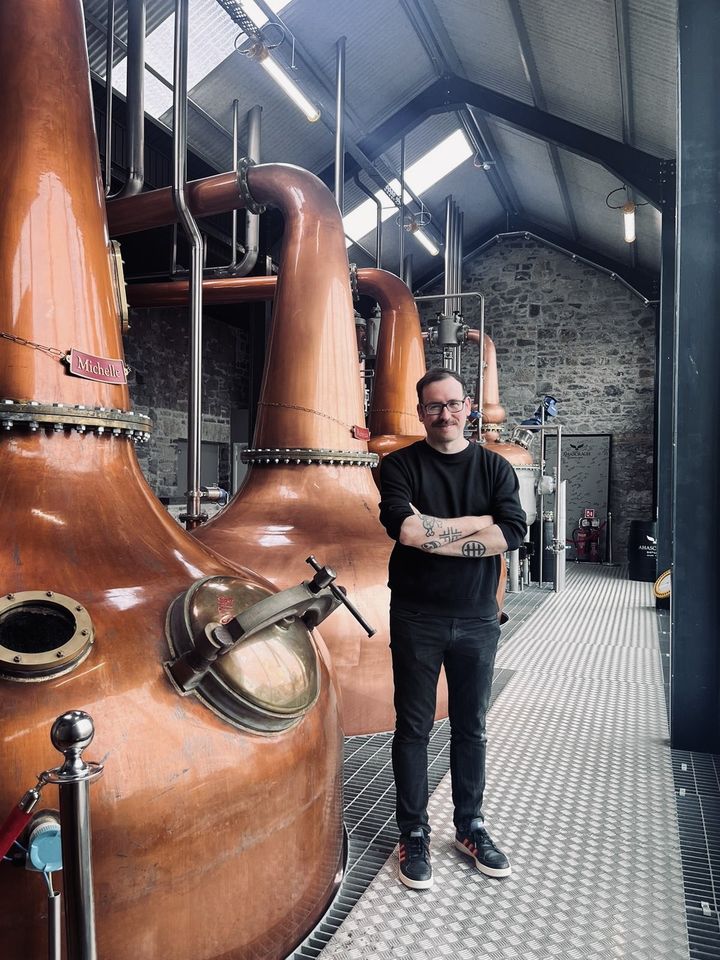“We passed through traditional townlands where we didn’t recognise the names, thatched roofs, antiquated chapels and colourful pubs” Conall pays a visit to Ahascragh Distillery I took it slow and opened my grip; letting the steering wheel slide through my hands as we rounded another meandering corner inland towards east Co Galway. Crossing the countless, sometimes nameless streams and tributaries of the lakes and waterways that punctuated the landscape, we’d tried to take stock. ‘It’s very green’, Megan said.
It was very green. Any time I’d found myself flying home I’d always appreciate the rising shades of fields and foliage long associated with this island, but this was something more. It was also a drive into the unfamiliar.

Traversing the country we’d focused on the geographical extremes; the northern coastlines of Antrim and Donegal – down the wild Atlantic way, or east towards sprawling Dublin City; paths well worn. To us this was a novel, hidden Ireland. Something new at every turn.
We passed through traditional townlands where we didn’t recognise the names, thatched roofs, antiquated chapels and colourful pubs, steadily approaching Ahascragh, our first stop. Ahascragh Distillery and the restored waterwheel Ahascragh Distillery From one green to another – Ahascragh is home to Ireland’s first zero energy emissions distillery. Housed in a tastefully restored former mill, fragrances of brewing grains flood the space upon entry.
The interior is compellingly industrial, with spotless state-of-the-art machinery, an internal bridge crossing the river below and a stunning still room at its centre, complete with wall-to-ceiling windows and exposed original brickwork. The award-winning distillery runs entirely on wind and solar powered energy, while the mill’s recovered waterwheel sits ready-and-waiting to provide further clean electricity. Our chaperon Shirley guides us seamlessly through the spirit-making process, explaining the complexities behind an eco-distillery and the tumultuous history of the storied building; finishing with a tasting of the delectable UAIS and Clan Colla 7 year old whiskeys, as well as the Xin Gin.
Megan enjoying the spread at Kylemore Farmhouse Kylemore Farmhouse Cheese To the south, among the fertile and ancient foothills of Slieve Aughty lies Kylemore Farmhouse, home to Swiss Alps inspired cheese, hand-made by the wonderful Teresa Roche and team. Three gleeful pups and their Dalmatian mum hasten to greet us as we coast to a halt outside the 200-year-old family home. It’s a marvel on the landscape, it could be as old as the hills themselves, imposing in its past and yet entirely in sync with the surroundings.
There’s a lady waving in the distance through a haze of summer drizzle. It’s Teresa. Wearing boots and overalls just after processing the latest batch of craft cheese, she kindly beckons us inside out of the mist to the farm shop.
Teresa and Conall at Kylemore Farmhouse A curated selection of farm-to-fork Irish produce garnish the shelves and we settle down to coffee and fresh milk, with a healthy dose of quality cream liquor. Teresa explains the cyclic struggles concurrent with maintaining a farm, but her passion and resolve is unwavering. She waxes lyrical of community and the region's heritage as we explore the cheese aging room, sampling keenly - working our way from young to mature.
The tour finishes with a stunning spread of cheese, crackers, fruit and other delicacies; then full of food and friendship we say our goodbyes. Travelling further inland over Portumna bridge, across the broad majestic Shannon into Co Tipperary we park up for the evening. The ageing room at Kylemore Farmhouse River Run House and Cottages Nestled in the centre of idyllic Terryglass, River Run House and Cottages offers luxury and comfort amidst picturesque scenery.
Beautifully landscaped gardens frame the row of self-catering cottages located just five minutes north of Lough Derg. Megan outside our River Run Cottage Inside is stylish, roomy and modern. There’s two elegantly decorated en-suite bedrooms upstairs, and a large kitchen/living/dining room on the ground floor with a fridge/freezer, dishwasher, oven, washer/dryer, Nespresso machine and an inviting log-burning stove should the weather call for an evening indoors.
Half-doors reveal a south-facing terrace, fully furnished with all-weather furniture in a private and tranquil setting. Salmon dish at Paddy's Bar Paddy’s Bar Across the street and over a small footbridge is Paddy’s Bar, where we’ve made our dinner reservation for the evening. We’re welcomed warmly into a busy and atmospheric pub open just shy of 200 years.
It’s a great spot; the staff are generous and attentive, the food home-cooked and locally produced, the Guinness substantial. The pizza menu is tempting, but after a long day of driving we opt for two courses – spicy pan-fried prawns for me followed by grilled salmon, and soup of the day with a curry main for Megan. It’s hearty, quality food, elegantly presented but with the deep depths of flavour you pray for in rural pub grub.
The Irish Workhouse Centre The Irish Workhouse Centre In the morning we retraced our steps back across the county border into the scenic town of Portumna. Steeped in history and culture, Portumna is home to The Irish Workhouse Centre, a carefully preserved museum dedicated to sharing the story of Ireland’s most poor and vulnerable; an essential piece of our past that could have easily been lost to time in these crumbling vestiges. Our guide Aileen sensitively walks us through the harsh realities of those forced to live and survive in one of the 163 workhouses spread across the country.
We’re shown where the ‘inmates’ worked, slept, ate, prayed and were punished through an essentially inescapable and cruel system that separated families and claimed countless lives from the early 1840s into the 1920s. Megan and Conall in Paddy's Bar Portumna Castle and Gardens A few minutes up the road is Portumna Castle, a dramatic semi-fortified house built around 1618 by the fourth earl of Clanricarde. It served as the main seat of the de Burgo family for over 200 years until it was gutted by a fire in 1826.
The castle is a unique example of the transitional Irish architecture of the early 1600s. Its bold design combines elements of medieval and Renaissance style that complement each other perfectly. A stroll through the main building acts as a time-machine, as conserved period furnishings and informative displays offer a window back through the centuries.
And the walled kitchen garden is a must-see. Archways, gazebos and hidden pathways channel you through row after row of vegetables, fruit, plants and trees - big and small, in a medley of colours, sights and smells. Conall, Dick and Megan at Dick's Bike Hire Dick’s Bike Hire Back in town we meet with Liz and Dick at their wonderful Pod Umna Village, a family-run glamping haven in the heart of Portumna.
Dick is a proper example of Portumna pride. We’re here to rent bikes, but Dick takes time to guide us through the streets and entries, rhapsodising on local history, art and culture, with anecdotes and memories in abundance. Dick exemplifies just how unique this area is - taking pleasure in and looking after your community is a powerful and recurrent theme.
High-vised and helmeted we cycled through town at a leisured pace. Down by the Blueway we watched locals, young and old dive and swim in the clear, brisk waters of Lough Derg. We raced under the sun, and stopped by the marina before ducking into the leafy shelter of Portumna Forest Park.
Conall and Megan at Dick's Bike Hire Beneath the trees it was a patchwork of sun and shade, and we cycled steadily now as a welcome breeze funnelled through us. We smiled hello to every passing rambler, before making a u-turn after I decided my legs couldn’t hack it. Returning through the castle grounds we passed the Abbey for the first time, a medieval friary founded in 1254.
This took me by surprise. I was struck hard that something so olden and significant could just be waiting, without fanfare, round the corner. Calling it a day, we retreated back across the border once more, under spectacular murmurations, south towards the Lakeside Hotel in Ballina.
Our Lakeside Hotel room The Lakeside Hotel Our room was stunning. Caringly escorted to a separate building right on the waterfront, we were left speechless at the awaiting 5-star lodging. Furnished with a super king-size Respa bed, Nespresso machine, fridge and welcome chocolates, our room had a private balcony on Lough Derg.
Boats puttered past as I stepped out and took in the scene. Across the lough, within touching distance was Killaloe, Co Clare. The tower of St Flannan's Cathedral still visible on the darkening skyline, as were the vibrant, multicoloured terraced houses along the shore.
The bathroom was huge, with a large tub, walk-in shower and wall-to-wall mirrors. Megan enjoying an Aperol at The Lakeside Hotel Downstairs, O'Hara's Bar offered panoramic views of the Shannon and not-so-distant Killaloe. The staff were wonderful; friendly, accommodating and skilled.
We settled down to cocktails, a whiskey sour and Aperol Spritz, before ordering dinner. Smoked salmon salad, followed by pan-seared seabass for me, and a burrata and Sicilian cherry tomato salad, then baked salmon with garlic prawns for Megan. The food was fresh, generous and distinct.
A delightful meal in a spectacular setting. Seabass in The Lakeside Hotel Killaloe River Cruise We’d been extremely lucky with the weather. It’d been sunny while we were out, and pouring when inside.
We'd wake to soaked grass being seared by the sun. This morning was no exception, and the conditions were perfect for a tour down the Shannon. The boat had an exposed platform atop, with seating and unforgettable all-round views, while downstairs was fashioned like a pub; wooden interior, the same fabric seating you’d find in any countryside bar, small rounded tables, and a fully stocked bar with table service.
Conall on the Killaloe River Cruise I settled down to a pint as the rugged hills and slopes rolled by the windows and traditional music sounded pleasantly through the room. This was the obvious way to see out our journey through the country’s hidden heartlands. The idea that these worlds can still exist down unassuming country lanes or behind a steel gate on a quiet street is incredible, even more incredible is the wholehearted want and welcome for us to discover them.
Everyone we encountered, without exception, received us with the utmost enthusiasm and care. They want us to discover them, it’s there to be had. Some of the animals at Kylemore Farm Stay updated with the latest events, inspiration for things to do and places to stay by visiting https://www.
discoverireland.ie/.



















